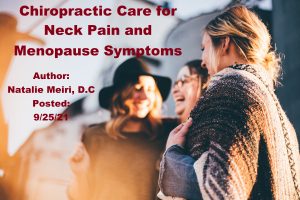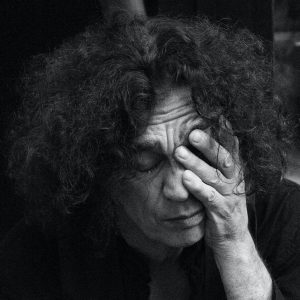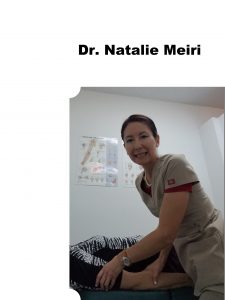
From Dr. Natalie Meiri’s Clinical Pearl Stories:
Chiropractic Care for Neck Pain and Menopause Symptoms
Author: Natalie Meiri, D.C. Posted: 9/25/21
This was a 52 year old female patient with a chief complaint of neck pain. To be HIPAA compliant, I will call her Tina instead of her real name. Tina had just reached menopause. This is when her neck pain came on. She also had headaches, hot flashes, night sweats, insomnia and increased anxiety or irritability.
Examination and x-rays
Positive tests were found for her spine during the exam. The x-rays taken in my office showed moderate osteoarthritis in her cervical (neck) spine. This is the “wear and tear” type of arthritis when the bones rub against one another causing pain, stiffness, inflammation, disc degeneration and bone spurs (also known as osteophytes) which can “pinch” surrounding nerves.
She also had positive tests for a cervicogenic headache. A cervicogenic headache is a headache that occurs because of a physical condition and structures in the neck. By addressing the cervicogenic component of the cervicogenic/tension type to migraine “continuum of headaches” her headaches would be reduced in intensity.

Treatment: Chiropractic Care for Neck Pain and Menopause Symptoms
Firstly, Tina’s treatments included chiropractic adjustment/ manipulation to her cervical (neck) spine and associated regions. Associated regions were thoracic (mid back), and lumbar (low back) spine. Secondly, soft tissue therapy (myofascial release, pressure point and various post isometric relaxation procedures) was rendered as necessary. Thirdly, modalities (cold/heat therapy and electric muscle stimulation) were administered. Finally, exercises for stretching, strengthening, and better posture were recommended.
Of course, because she had reached menopause, the headaches were also due to hormonal changes. She added soy products, fruits (i.e. berries), seeds (i.e. flaxseeds), and nuts to her diet. These foods have phytoestrogens or plant-based estrogens called isoflavones. These are plant chemicals capable of exerting estrogen like effects. Eating these foods in moderation along with some medicinal herbs helped to alleviate menopause symptoms for Tina.
Additionally, I did several homeopathic consultations with Tina and prescribed a number of homeopathic medicines. Obviously, Tina was against drugs when possible and wanted to deal with this naturally.
Tina started feeling better gradually for her chief complaint of neck pain. Moreover, her headaches disappeared. Tina’s hot flashes and night sweats decreased. To prevent osteoporosis due the estrogen loss in menopause, she took calcium supplements. Tina also started a exercise regimen which included weight bearing aerobic activity. Similarly, Tina started sleeping better due to everything she was doing. Lastly, her irritability and anxiety went away so she was happier than she had been in a long time.
How do menopause symptoms occur?
After 12 months without menstruating, a woman is in menopause. The average age of menopause onset in the Unites States is 51.
Decreased circulating levels of estrogen with menopause appear to affect the central nervous system via the hypothalamus. The hypothalamus is a small but important area in the center of the brain between the pituitary gland and thalamus. It plays an important role in hormone production and helps to stimulate many important processes in the body. The hypothalamus controls body temperature, thirst, hunger, and other homeostatic systems. It is also involved in sleep and emotional activity.
So 95% of perimenopausal and menopausal women experience “hot flashes”. These flushing and sweating episodes are sudden in onset and last several minutes. A sensation of face and neck hotness extends to the front of the chest. The skin temperature may increase as much as 2-5° degrees more and may result in wetting of clothing through excess perspiration. Physiologic responses that also occur include an increase in heart rate perceived sometimes as palpitations.
Furthermore, there may be symptoms of headache, dizziness, and nausea during the episodes. Many women have night sweats and also have difficulty falling asleep. And often awaken early without being able to fall back to sleep. Approximately 80% of women experience these episodes for more than 1 year with as many as 20% of women having symptoms for more than 5 years.
Menopause and Joint Pain
A common symptom often associated with hormonal changes is pain. More than half of women experience Arthralgia (pain in a joint) around the time of menopause. The causes of joint pain in postmenopausal women can be difficult to determine as the period of menopause coincides with a rising incidence of chronic rheumatic conditions such as osteoarthritis. Nevertheless, the prevalence of arthralgia does appear to increase in women going through menopausal transition. Studies have shown this to result from reduction in estrogen levels. This may have to do with various interactions between sex hormones and pain processing pathways, immune cells and chondrocytes (cartilage cells).

Given a growing concern regarding estrogen replacement therapy, a search for alternatives in the management of menopause is prevalent. Many studies have found that the use of alternative therapies for menopause symptoms is common, and women who use them generally find them to be beneficial. Chiropractic intervention in the treatment of postmenopausal climacteric symptoms especially in the area of joint pain and headaches is effective.
Meiri Chiropractic in West Palm Beach offers the best Chiropractic Relief of Neck, Back and Menopause Symptoms. Call us at 561-253-8984 in West Palm Beach to schedule an appointment at our chiropractic clinic and start getting the relief you need.